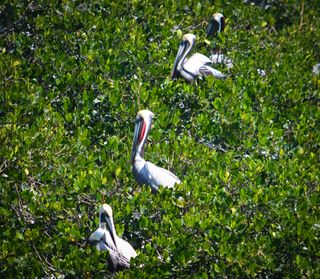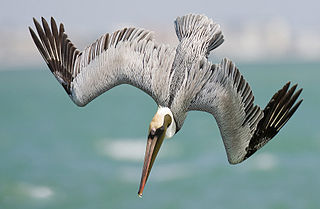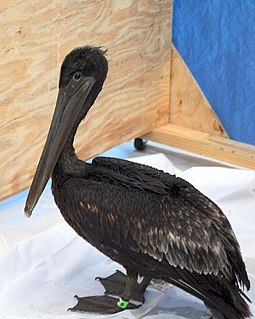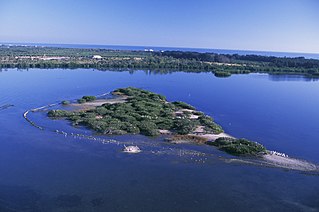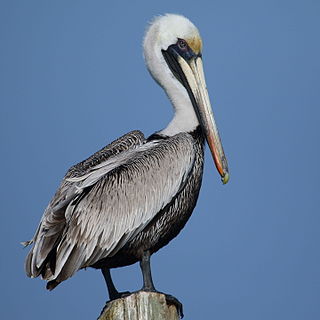Brown pelican: Difference between revisions
mNo edit summary |
mNo edit summary |
||
| (19 intermediate revisions by the same user not shown) | |||
| Line 1: | Line 1: | ||
<div class="irlbody"> | <div class="irlbody"> | ||
{{IRL header | {{IRL header estuary|cat=Biota}} | ||
<div class="irlcontenttop"> | |||
<p class="irlsubtitle">In 1903, President Theodore Roosevelt set aside the first National Wildlife Refuge, Florida's Pelican Island, to protect the Brown pelican from plume hunters.</p> | <p class="irlsubtitle">In 1903, President Theodore Roosevelt set aside the first National Wildlife Refuge, Florida's Pelican Island, to protect the Brown pelican from plume hunters.</p> | ||
==Appearance== | |||
[[File:Brown pelican in flight (Bodega Bay).jpg|alt=Brown pelican (Pelecanus occidentalis) in flight.|320x320px|thumb|'''[[Brown pelican]]'''<br/>'' Pelecanus occidentalis'']] | |||
The Brown pelican (Pelecanus occidentalis), also called American brown pelican or common pelican, is the smallest of the six different species of pelicans in the world. | |||
Brown pelicans can reach a length of 54 inches long, weigh 8 to 10 pounds, and have a wingspan between 6-1/2 feet and 7-1/2 feet.<ref name="bpfactsheet" /> They have a long beak up to 13.5 inches in length with a hooked tip.<ref name="fws10bp" /> Like all Pelecanidae family members, the brown pelican has a large throat pouch used for catching prey. | Brown pelicans can reach a length of 54 inches long, weigh 8 to 10 pounds, and have a wingspan between 6-1/2 feet and 7-1/2 feet.<ref name="bpfactsheet" /> They have a long beak up to 13.5 inches in length with a hooked tip.<ref name="fws10bp" /> Like all Pelecanidae family members, the brown pelican has a large throat pouch used for catching prey. | ||
| Line 15: | Line 15: | ||
During the breeding season, the plumage (feathers) turns bright yellow on the head and white on the neck, which both fade to dull yellow and brown during non-breeding. Juvenile brown pelicans typically have brown heads that match body coloration and a white stomach. | During the breeding season, the plumage (feathers) turns bright yellow on the head and white on the neck, which both fade to dull yellow and brown during non-breeding. Juvenile brown pelicans typically have brown heads that match body coloration and a white stomach. | ||
==Range== | ==Range== | ||
[[File: | [[File:Brown_pelican_roost.jpg|320x320px|thumb|alt=Rare red-beaked Brown pelican roosting in mangroves.|Rare red-beaked Brown Pelican in Mangrove]] | ||
The brown pelican, inhabits the Atlantic, Pacific, and Gulf Coasts of North and South America. On the Atlantic Coast, the species can be found from Nova Scotia to Venezuela, and on the Pacific Coast, from British Columbia to south-central Chile and the Galapagos Islands. On the Gulf Coast, the species is found in Florida, Alabama, Louisiana, Texas, Mississippi, and Mexico.<ref name="bpfactsheet" /> | The brown pelican, inhabits the Atlantic, Pacific, and Gulf Coasts of North and South America. On the Atlantic Coast, the species can be found from Nova Scotia to Venezuela, and on the Pacific Coast, from British Columbia to south-central Chile and the Galapagos Islands. On the Gulf Coast, the species is found in Florida, Alabama, Louisiana, Texas, Mississippi, and Mexico.<ref name="bpfactsheet" /> | ||
Brown pelicans aren't usually seen more than 20 miles offshore.<ref name="fws10bp" /> In Florida, brown pelicans are widespread along the coast and can be seen on inland waters during the non-breeding season. | Brown pelicans aren't usually seen more than 20 miles offshore.<ref name="fws10bp" /> In Florida, brown pelicans are widespread along the coast and can be seen on inland waters during the non-breeding season. | ||
==Habitat== | ==Habitat== | ||
Brown Pelicans live year-round in estuaries and coastal marine habitats along both the east and west coasts. | Brown Pelicans live year-round in estuaries and coastal marine habitats along both the east and west coasts. When not feeding or nesting, brown pelicans rest on sandbars, pilings, jetties, breakwaters, mangrove islets, and offshore rocks. | ||
Brown pelicans breed between Maryland and Venezuela, and between southern California and southern Ecuador. On the Atlantic and Gulf coasts they breed mostly on barrier and {{Define|estuarine}} islands. On the West Coast they breed on dry, rocky offshore islands. | |||
In Florida's Indian River Lagoon, Brown pelicans primarily roost in mangrove trees growing on shorelines and spoil islands. | |||
==Behavior== | ==Behavior== | ||
[[File:Pelican-dive-3.jpg| | [[File:Pelican-dive-3.jpg|320x320px|thumb|alt=Brown pelican diving for food.|Brown pelican diving]] | ||
Though they appear awkward on land, Brown pelicans are strong swimmers and masterful fliers. They fly to and from their fishing grounds in V-formations or lines just above the water’s surface. Pelicans fly with their necks folded and their heads resting on their backs, using slow, powerful wing beats. | Though they appear awkward on land, Brown pelicans are strong swimmers and masterful fliers. They fly to and from their fishing grounds in V-formations or lines just above the water’s surface. Pelicans fly with their necks folded and their heads resting on their backs, using slow, powerful wing beats. | ||
| Line 40: | Line 38: | ||
The Brown pelican has a very unique way of foraging, unlike other pelicans species who work in flocks to corral their prey, brown pelicans dive headfirst into the water from 50 heights to catch fish near the surface. Diving steeply into the water, they may submerge completely or only partly, depending on the height of the dive, and come up with a mouthful of fish. Air sacs beneath their skin cushion the impact and help the pelicans surface. Once they capture the fish, they tip their head upward or to the side to drain the water from their bill pouch. Pelicans usually forage during the day but may feed at night during a full moon. | The Brown pelican has a very unique way of foraging, unlike other pelicans species who work in flocks to corral their prey, brown pelicans dive headfirst into the water from 50 heights to catch fish near the surface. Diving steeply into the water, they may submerge completely or only partly, depending on the height of the dive, and come up with a mouthful of fish. Air sacs beneath their skin cushion the impact and help the pelicans surface. Once they capture the fish, they tip their head upward or to the side to drain the water from their bill pouch. Pelicans usually forage during the day but may feed at night during a full moon. | ||
[[File:Pelecanus occidentalis -Smith Island, Chesapeake Bay, Maryland, USA -nest-8cr.jpg| | [[File:Pelecanus occidentalis -Smith Island, Chesapeake Bay, Maryland, USA -nest-8cr.jpg|320x320px|thumb|alt=An adult Brown Pelican with a chick on their nest|An adult Brown Pelican with a chick on their nest]] | ||
Brown pelicans become sexually mature between the age of three and five years old. Social and gregarious, brown pelicans breed in large colonies, called rookeries, located in mangrove trees and shrubs on estuarine islands. The Brown Pelican mating season is March through May in most of the United States nesting range. | Brown pelicans become sexually mature between the age of three and five years old. Social and gregarious, brown pelicans breed in large colonies, called rookeries, located in mangrove trees and shrubs on estuarine islands. The Brown Pelican mating season is March through May in most of the United States nesting range. | ||
The male brown pelican selects a nesting site and then tries to attract a female with a dance of head movements. Once a female selects a male, the male will bring her sticks, reeds and grass for the nest. The female accepts the materials with a sway of her head and then weaves them into the nest. It can take over a week to build the nest. The nest can be built on the ground, in a tree, or in a bush. | |||
Females lay one to four white eggs, and incubation can take up to 30 days. Both adults incubate and feed the nestlings, which are blind, featherless, and completely dependent upon their parents. They soon develop soft and silky down, followed by feathers. | Females lay one to four white eggs, and incubation can take up to 30 days. Both adults incubate and feed the nestlings, which are blind, featherless, and completely dependent upon their parents. They soon develop soft and silky down, followed by feathers. | ||
| Line 50: | Line 48: | ||
The length of time that the young pelicans stay in the nest varies with latitude, but they generally leave the nest within two to three months.<ref name="nzbp" /> | The length of time that the young pelicans stay in the nest varies with latitude, but they generally leave the nest within two to three months.<ref name="nzbp" /> | ||
==Threats== | ==Threats== | ||
[[File:Oil spill Mobile - Briefings & Oiled Bird cleaning 077 oiled brown pelican before cleaning (5014727141).jpg|320x320px|thumb|alt=Cleaning a Brown pelican after oil spill.|Oiled Brown Pelican]] | |||
Brown pelicans have few natural enemies. Although ground nests are sometimes destroyed by natural disasters or predators, the biggest threat to pelicans comes from people. | Brown pelicans have few natural enemies. Although ground nests are sometimes destroyed by natural disasters or predators, the biggest threat to pelicans comes from people. | ||
In the late 19th and early 20th centuries, pelicans were hunted for their plumage (feathers), which adorned women’s hats and clothing. Several conservation efforts in the early part of the 20th century were meant to curb the harvest of birds, including brown pelicans, for their feather plumes. | In the late 19th and early 20th centuries, pelicans were hunted for their plumage (feathers), which adorned women’s hats and clothing. Several conservation efforts in the early part of the 20th century were meant to curb the harvest of birds, including brown pelicans, for their feather plumes. | ||
| Line 70: | Line 66: | ||
Discarded fishing line also threatens Brown pelicans, along with many other marine animals. It has been estimated that more than 700 pelicans die each year in Florida alone from entanglement in fishing gear.<ref name="bphistory" /> | Discarded fishing line also threatens Brown pelicans, along with many other marine animals. It has been estimated that more than 700 pelicans die each year in Florida alone from entanglement in fishing gear.<ref name="bphistory" /> | ||
==Conservation== | ==Conservation== | ||
[[File:Aerial of Pelican Island National Willdife Refuge.jpg| | [[File:Aerial of Pelican Island National Willdife Refuge.jpg|320x320px|thumb|alt=Aerial of Pelican Island National Wildlife Refuge.|Pelican Island National Wildlife Refuge]] | ||
The decimation of Florida's Brown pelicans by plume hunters inspired Florida bird advocate's Frank Chapman and [[Paul Kroegel]] to persuade President Theodore Roosevelt to protect Florida's birds from the plumage trade. | The decimation of Florida's Brown pelicans by plume hunters inspired Florida bird advocate's Frank Chapman and [[Paul Kroegel]] to persuade President Theodore Roosevelt to protect Florida's birds from the plumage trade. | ||
On March 14, 1903, Roosevelt signed an executive order to the effect: ''"It is hereby ordered that Pelican Island in Indian River. . . is hereby, reserved and set apart for the use of the Department of Agriculture as a preserve and breeding ground for native birds."''<ref name="kroegel" /> | On March 14, 1903, Roosevelt signed an executive order to the effect:<br/> | ||
''"It is hereby ordered that Pelican Island in Indian River. . . is hereby, reserved and set apart for the use of the Department of Agriculture as a preserve and breeding ground for native birds."''<ref name="kroegel" /> | |||
With that declaration, Pelican Island in Sebastian, Florida became the first segment of what would eventually become the U.S. National Wildlife Refuge System. [https://www.fws.gov/refuge/Pelican_Island Pelican Island National Wildlife Refuge] is a testament to the value of the U.S. Fish and Wildlife Service and to the success of public {{Define|conservation}} efforts. | With that declaration, Pelican Island in Sebastian, Florida became the first segment of what would eventually become the U.S. National Wildlife Refuge System. [https://www.fws.gov/refuge/Pelican_Island Pelican Island National Wildlife Refuge] is a testament to the value of the U.S. Fish and Wildlife Service and to the success of public {{Define|conservation}} efforts. | ||
| Line 84: | Line 78: | ||
While the establishment of America’s first National Wildlife Refuge helped reduce hunting pressure on the pelican population, the [https://www.fws.gov/birds/policies-and-regulations/laws-legislations/migratory-bird-treaty-act.php Migratory Bird Treaty Act of 1918] provided birds with even more protection and worked to end illegal harvests. | While the establishment of America’s first National Wildlife Refuge helped reduce hunting pressure on the pelican population, the [https://www.fws.gov/birds/policies-and-regulations/laws-legislations/migratory-bird-treaty-act.php Migratory Bird Treaty Act of 1918] provided birds with even more protection and worked to end illegal harvests. | ||
[[File:Pelecanus occidentalis Caye Caulker 03.JPG| | [[File:Pelecanus occidentalis Caye Caulker 03.JPG|320x320px|thumb|alt=Adult Brown Pelican (Pelecanus occidentalis)|Adult Brown Pelican]] | ||
In 1970, the [[United_States_Fish_and_Wildlife_Service|U.S. Fish and Wildlife Service]] listed the brown pelican as endangered, which means the species is in danger of extinction throughout all or a significant portion of its range. This status protects the pelican from being directly or indirectly impacted by humans. | In 1970, the [[United_States_Fish_and_Wildlife_Service|U.S. Fish and Wildlife Service]] listed the brown pelican as endangered, which means the species is in danger of extinction throughout all or a significant portion of its range. This status protects the pelican from being directly or indirectly impacted by humans. | ||
In 1972, the [https://www.epa.gov/ Environmental Protection Agency] banned the use of DDT in the United States and restricted the use of other pesticides. | In 1972, the [https://www.epa.gov/ Environmental Protection Agency] banned the use of DDT in the United States and restricted the use of other pesticides. | ||
As a result of the ban on the use of DDT in the United States and effective management, Brown pelicans made a strong comeback. The U.S. Fish and Wildlife Service removed the endangered status for brown pelicans on the Atlantic and Gulf coasts of the U.S., including Florida, on February 4, 1985. The population segment that remained listed, including the Gulf Coast in Mississippi, Louisiana, and Texas, was also removed from the [https://www.fws.gov/endangered/ Federal List of Endangered and Threatened Wildlife] on December 17, 2009.<ref name="fws2009" /> | As a result of the ban on the use of DDT in the United States and effective management, Brown pelicans made a strong comeback. The U.S. Fish and Wildlife Service removed the endangered status for brown pelicans on the Atlantic and Gulf coasts of the U.S., including Florida, on February 4, 1985. | ||
The population segment that remained listed, including the Gulf Coast in Mississippi, Louisiana, and Texas, was also removed from the [https://www.fws.gov/endangered/ Federal List of Endangered and Threatened Wildlife] on December 17, 2009.<ref name="fws2009" /> | |||
Brown pelicans have responded well to conservation efforts to protect, restore, and manage rookery islands. These actions improved reproductive success in restoring the birds to their historic numbers. The U.S. Fish and Wildlife Service now estimates the global population of brown pelicans at 650,000 individuals.<ref name="bpfactsheet" /> | Brown pelicans have responded well to conservation efforts to protect, restore, and manage rookery islands. These actions improved reproductive success in restoring the birds to their historic numbers. The U.S. Fish and Wildlife Service now estimates the global population of brown pelicans at 650,000 individuals.<ref name="bpfactsheet" /> | ||
</div> | </div> | ||
<div class=" | <div class="irlvideo"> | ||
==Brown Pelican Video== | |||
Please select a Brown Pelican video to view. | |||
{{#evl:BfEboMmwAMw|How Do Brown Pelicans Survive Their Death-Defying Dives?|1|player=youtube}} | {{#evl:BfEboMmwAMw|How Do Brown Pelicans Survive Their Death-Defying Dives?|1|player=youtube}} | ||
| Line 104: | Line 100: | ||
{{#evl:p-q3c-hZNQc|Brown Pelican Feeding Nestlings|3|player=youtube}} | {{#evl:p-q3c-hZNQc|Brown Pelican Feeding Nestlings|3|player=youtube}} | ||
<evlplayer w=" | <evlplayer w="340" h="220" id="youtube" style="width:inherit;"><div style="width:320px;">https://img.youtube.com/vi/BfEboMmwAMw/0.jpg</div></evlplayer> | ||
</div> | </div> | ||
<div class="irlcontentbottom"> | <div class="irlcontentbottom"> | ||
==See Also== | |||
[[Brown Pelican Pictures|Brown Pelican Photo Gallery]] | |||
==Weblinks== | ==Weblinks== | ||
* [https://nationalzoo.si.edu/migratory-birds/species-profile-brown-pelican National Zoo - Brown Pelican Profile] | * [https://nationalzoo.si.edu/migratory-birds/species-profile-brown-pelican National Zoo - Brown Pelican Species Profile] | ||
* [https://nationalzoo.si.edu/animals/brown-pelican National Zoo - Brown Pelican] | * [https://nationalzoo.si.edu/animals/brown-pelican National Zoo - Brown Pelican] | ||
* [https://myfwc.com/wildlifehabitats/profiles/birds/shorebirdsseabirds/brown-pelican/ FWC - Brown Pelican] | * [https://myfwc.com/wildlifehabitats/profiles/birds/shorebirdsseabirds/brown-pelican/ FWC - Brown Pelican] | ||
| Line 139: | Line 135: | ||
</references> | </references> | ||
</div> | </div> | ||
{{IRL footer | {{IRL footer estuary|cat=Biota}} | ||
</div> | </div> | ||
[[Category:Land Animals]] | [[Category:Land Animals]] | ||
Latest revision as of 06:49, November 30, 2021
In 1903, President Theodore Roosevelt set aside the first National Wildlife Refuge, Florida's Pelican Island, to protect the Brown pelican from plume hunters.
Appearance
The Brown pelican (Pelecanus occidentalis), also called American brown pelican or common pelican, is the smallest of the six different species of pelicans in the world.
Brown pelicans can reach a length of 54 inches long, weigh 8 to 10 pounds, and have a wingspan between 6-1/2 feet and 7-1/2 feet.[1] They have a long beak up to 13.5 inches in length with a hooked tip.[2] Like all Pelecanidae family members, the brown pelican has a large throat pouch used for catching prey.
Pelicans are long-lived seabirds. One pelican captured in Florida had been banded 31 years earlier![1]
Brown pelicans can be identified by their chestnut-and-white necks; white heads with pale yellow crowns; brown-streaked back, rump, and tail; blackish-brown belly; grayish bill and pouch; and black legs and feet.[1]
During the breeding season, the plumage (feathers) turns bright yellow on the head and white on the neck, which both fade to dull yellow and brown during non-breeding. Juvenile brown pelicans typically have brown heads that match body coloration and a white stomach.
Range
The brown pelican, inhabits the Atlantic, Pacific, and Gulf Coasts of North and South America. On the Atlantic Coast, the species can be found from Nova Scotia to Venezuela, and on the Pacific Coast, from British Columbia to south-central Chile and the Galapagos Islands. On the Gulf Coast, the species is found in Florida, Alabama, Louisiana, Texas, Mississippi, and Mexico.[1]
Brown pelicans aren't usually seen more than 20 miles offshore.[2] In Florida, brown pelicans are widespread along the coast and can be seen on inland waters during the non-breeding season.
Habitat
Brown Pelicans live year-round in estuaries and coastal marine habitats along both the east and west coasts. When not feeding or nesting, brown pelicans rest on sandbars, pilings, jetties, breakwaters, mangrove islets, and offshore rocks.
Brown pelicans breed between Maryland and Venezuela, and between southern California and southern Ecuador. On the Atlantic and Gulf coasts they breed mostly on barrier and estuarine islands. On the West Coast they breed on dry, rocky offshore islands.
In Florida's Indian River Lagoon, Brown pelicans primarily roost in mangrove trees growing on shorelines and spoil islands.
Behavior
Though they appear awkward on land, Brown pelicans are strong swimmers and masterful fliers. They fly to and from their fishing grounds in V-formations or lines just above the water’s surface. Pelicans fly with their necks folded and their heads resting on their backs, using slow, powerful wing beats.
Pelicans are primarily fish-eaters, requiring up to four pounds of fish a day. Their diet consists mainly of “rough” fish such as menhaden, herring, sheepshead, pigfish, mullet, grass minnows, topminnows, and silversides. The birds have also been known to eat some crustaceans, usually prawns.
The Brown pelican has a very unique way of foraging, unlike other pelicans species who work in flocks to corral their prey, brown pelicans dive headfirst into the water from 50 heights to catch fish near the surface. Diving steeply into the water, they may submerge completely or only partly, depending on the height of the dive, and come up with a mouthful of fish. Air sacs beneath their skin cushion the impact and help the pelicans surface. Once they capture the fish, they tip their head upward or to the side to drain the water from their bill pouch. Pelicans usually forage during the day but may feed at night during a full moon.
Brown pelicans become sexually mature between the age of three and five years old. Social and gregarious, brown pelicans breed in large colonies, called rookeries, located in mangrove trees and shrubs on estuarine islands. The Brown Pelican mating season is March through May in most of the United States nesting range.
The male brown pelican selects a nesting site and then tries to attract a female with a dance of head movements. Once a female selects a male, the male will bring her sticks, reeds and grass for the nest. The female accepts the materials with a sway of her head and then weaves them into the nest. It can take over a week to build the nest. The nest can be built on the ground, in a tree, or in a bush.
Females lay one to four white eggs, and incubation can take up to 30 days. Both adults incubate and feed the nestlings, which are blind, featherless, and completely dependent upon their parents. They soon develop soft and silky down, followed by feathers.
At least one parent stays with the young at all times for the first month to month-and-a-half. The parents take turns feeding the young, initially by regurgitating small and well-digested fish onto the floor of the nest for the nestlings to eat. As they grow, the nestlings begin feeding on whole fish by reaching their heads into the pouch under the parent’s bill.
The length of time that the young pelicans stay in the nest varies with latitude, but they generally leave the nest within two to three months.[3]
Threats
Brown pelicans have few natural enemies. Although ground nests are sometimes destroyed by natural disasters or predators, the biggest threat to pelicans comes from people.
In the late 19th and early 20th centuries, pelicans were hunted for their plumage (feathers), which adorned women’s hats and clothing. Several conservation efforts in the early part of the 20th century were meant to curb the harvest of birds, including brown pelicans, for their feather plumes.
During the food shortages following World War I, commercial fishermen claimed pelicans were decimating their industry and slaughtered them by the thousands. The nests were also frequently raided for eggs.
From the 1940s to the 1970s, DDT (dichlorodiphenyltrichloroethane) pesticide used to control mosquitoes had an unintentional effect that almost drove brown pelicans to extinction. When pelicans ate fish contaminated with DDT, the eggs that they laid had shells so thin that they broke during incubation. This led to low rates of nest success, and populations of pelicans were wiped out. By the 1960s, brown pelicans had nearly disappeared along the Gulf Coast and experienced almost complete reproductive failure in southern California. Brown pelicans were almost entirely lost from North America between 1950 and 1970.
Endrin (Endrin aldehyde), once used as a popular insecticide and rodenticide, was another chemical spread to pelicans through the consumption of aquatic organisms. This chemical was highly toxic to birds and directly led to significant pelican mortality.
The primary threat that pelicans currently face is pollution. It is estimated that 82,000 birds were killed in the 2010 Deepwater Horizon oil spill, including one out of every 10 brown pelicans in the Gulf of Mexico.[3]
Plastic trash is a major threat to pelicans and other shorebirds. The toxic chemicals in plastics can be harmful to birds, and they can be strangled by strips of plastic. Birds also often mistake plastic items for food, and their stomachs can become so filled with plastic items that they die from starvation. A 2015 study found that nine out of every 10 seabirds have plastic in their stomachs.[3]
Discarded fishing line also threatens Brown pelicans, along with many other marine animals. It has been estimated that more than 700 pelicans die each year in Florida alone from entanglement in fishing gear.[4]
Conservation
The decimation of Florida's Brown pelicans by plume hunters inspired Florida bird advocate's Frank Chapman and Paul Kroegel to persuade President Theodore Roosevelt to protect Florida's birds from the plumage trade.
On March 14, 1903, Roosevelt signed an executive order to the effect:
"It is hereby ordered that Pelican Island in Indian River. . . is hereby, reserved and set apart for the use of the Department of Agriculture as a preserve and breeding ground for native birds."[5]
With that declaration, Pelican Island in Sebastian, Florida became the first segment of what would eventually become the U.S. National Wildlife Refuge System. Pelican Island National Wildlife Refuge is a testament to the value of the U.S. Fish and Wildlife Service and to the success of public conservation efforts.
While the establishment of America’s first National Wildlife Refuge helped reduce hunting pressure on the pelican population, the Migratory Bird Treaty Act of 1918 provided birds with even more protection and worked to end illegal harvests.
In 1970, the U.S. Fish and Wildlife Service listed the brown pelican as endangered, which means the species is in danger of extinction throughout all or a significant portion of its range. This status protects the pelican from being directly or indirectly impacted by humans.
In 1972, the Environmental Protection Agency banned the use of DDT in the United States and restricted the use of other pesticides.
As a result of the ban on the use of DDT in the United States and effective management, Brown pelicans made a strong comeback. The U.S. Fish and Wildlife Service removed the endangered status for brown pelicans on the Atlantic and Gulf coasts of the U.S., including Florida, on February 4, 1985.
The population segment that remained listed, including the Gulf Coast in Mississippi, Louisiana, and Texas, was also removed from the Federal List of Endangered and Threatened Wildlife on December 17, 2009.[6]
Brown pelicans have responded well to conservation efforts to protect, restore, and manage rookery islands. These actions improved reproductive success in restoring the birds to their historic numbers. The U.S. Fish and Wildlife Service now estimates the global population of brown pelicans at 650,000 individuals.[1]
Brown Pelican Video
Please select a Brown Pelican video to view.
How Do Brown Pelicans Survive Their Death-Defying Dives?
See Also
Weblinks
- National Zoo - Brown Pelican Species Profile
- National Zoo - Brown Pelican
- FWC - Brown Pelican
- FWS - Species Profile - Brown Pelican
- FWS - 10,000 Islands Refuge - Brown Pelican
- FWS - 2009 Brown Pelican Press Release
- Audubon Guide to North American Birds: Brown Pelican
- Cornell Lab - Brown Pelican Life History
Documents
- FWS Brown Pelican Factsheet, (PDF 2pp 280KB), 2009
- FWC A Species Action Plan for the Brown Pelican, (PDF 40pp 1.77MB)
- FWC 2011 Brown Pelican Biological Status Review Report, (PDF 17pp 629KB), 2011
- FWC Breeding Bird Atlas - Brown Pelican, (PDF 3pp 191KB)
- Studies of the Brown Pelican, (PDF 17pp 922KB), 1972
- Paul Kroegel - America's First National Wildlife Refuge Manager, (PDF 1p 98KB)


